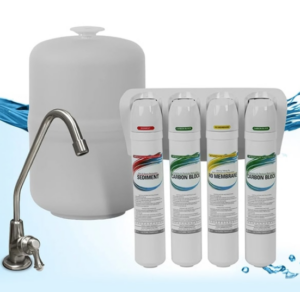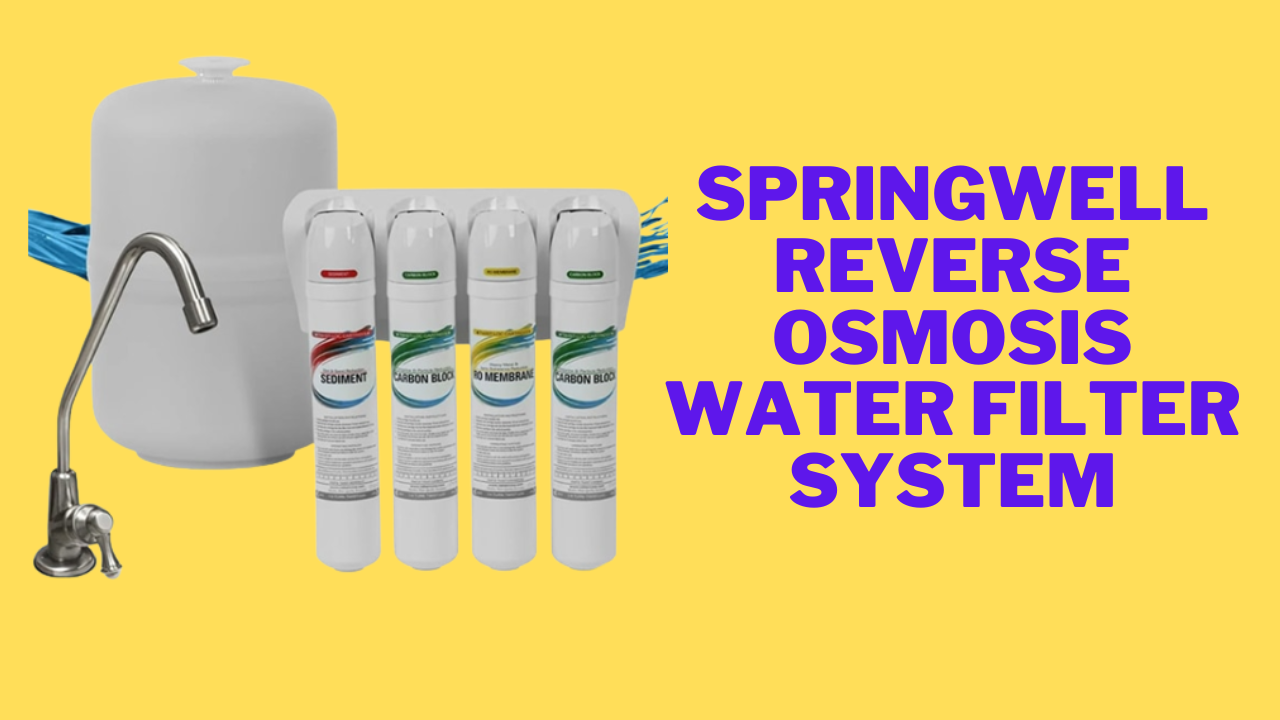To keep oneself healthy, potable water quality is crucial. Without any effort, you can purify your family’s drinking and cooking water using a reverse osmosis water filter.
Water filtration is important to me because as a mom, my number one concern is the well-being of my children. There can be no compromise when it comes to the water my family consumes; it is fundamental to our health and well-being. When you install a reverse osmosis (RO) system in your house, you can rest easy knowing that your water source is safe.
In this post on the SpringWell reverse osmosis reviews, we will go over the benefits and drawbacks, show you how to set it up, and evaluate how well it works.
Springwell Reverse Osmosis Specification Table
| Features | Springwell Reverse Osmosis |
| Maintenance | Easy |
| Filtration stages | 4 |
| Contaminants removal | 99.9% |
| Installation | Easy |
Springwell RO Water Filter System
If you want to remove contaminants like lead and fluoride from your water supply, the SpringWell R/O filter is what you need. With its small footprint and 75 gallons of treated water per day, the SWRO-Nickel is the perfect point-of-use water filter for your kitchen sink. Quickly and easily installed; with the 1/4-turn replacement filters, you won’t even need to turn off the water to change them!

Installation
With everything you need already included, setting up the system is a breeze. If you like to do things on your own, this is something you can manage. Springwell’s installation will take slightly more than an hour. All you need is a drill for this task.
You have the option to employ a plumber to do the installation if you feel uneasy doing it yourself. A professional should have no trouble with it and it shouldn’t cost too much as it is a point-of-use system.
Flow rate
The unit’s total flow rate is great at this time, according to SpringWell. That is proportional to the amount of water in the tank. The water drains quickly once the tank is full. The water pressure could drop if the tank is low on water volume or if the tank is empty.
A sediment filter can handle 0.5 GPM of flow, whereas a carbon filter can handle 1.9 GPM. About 1 GPM is the total flow rate. For both cooking and drinking, it’s more than plenty.
Maintenance
After installation, the system requires nothing in the way of upkeep. Costing $25 to $35 apiece, the pre- and post-filters only require replacement every six months. The semipermeable RO membrane, which costs around $150, has a 24-month lifespan at the very least.
Filter replacement is a breeze thanks to the innovative twist-and-lock mechanism. You can do it without tools or a filter wrench. A quarter turn of the filter is all it takes. Plus, unlike other RO versions that employ external filter housings, this one won’t house germs because of its integrated filter cartridge design.
Capacity for Filtration
With its huge daily filtering capacity, this unit is perfect for a big household. The water storage tank has a capacity of 3.2 gallons. As soon as you remove water from the tank, the device resumes filtering. There is a daily capacity of 75 gallons for filtering. Household RO systems typically have a daily flow rate of 40-50 gallons.
Replacements
According to SpringWell, you should change the RO membrane every 24 months and the other three filters every 6 months. You could need to replace the filters sooner rather than later, though, if the water is really bad or not used enough. It is normally necessary to change the cartridges when you notice a noticeable decline in the water quality and flow rate.
Contaminants Removal
Water from both wells and cities may have nearly all impurities removed by this technique. Everything revolves around the RO membrane. SpringWell’s RO membrane is a thin film composite, thus it can filter out practically any impurity in water, including microbes, heavy metals, pesticides, herbicides, and volatile organic compounds.
It works just as well against aluminum, fluoride, lead, mercury, arsenic, chlorine, and chloramines. Concerns regarding the safety of your drinking water supply will disappear once the system is in place.
How does Springwell SWRO-Nickel work?
There are four levels of filtering in the Springwell SWRO-Nickel system.
Step 1: Sediment filtration
The first step is a 25-micron sediment filter that sorts through the water entering the system and eliminates any debris such as silt, dust, sand, grime, rust, hair, or other suspended particles.
Step 2: Carbon filtration
The second step involves a carbon filter that collects volatile organic compounds (VOCs) such as chlorine, chloramine, herbicides, insecticides, and others.
Step 3: RO filtration
The third stage is when the bulk of the action takes place. The RO membrane can filter out practically all water pollutants, including bacteria, heavy metals, and total dissolved solids. The water barely passes through the RO membrane due to its tiny size. For this reason, RO filtering is slower than alternatives.
Step 4: Pollutants Removal
The fourth and last stage is a carbon filter that enhances the visual appeal of the water while simultaneously removing any remaining pollutants.
Pros And Cons
Pros
- Great filtration capacity
- Removes up to 99.9% of microbes in water
- Compact design
- Easy installation
Cons
- Expensive
For what reasons is Springwell SWRO-Nickel superior?
Extra filtration
For optimal reverse osmosis membrane performance and removal of most typical well water impurities, the optimum system is the SpringWell Reverse Osmosis Water Filter System, which incorporates extra filter stages.
Easy to replace
Its 1/4-turn filter design makes filter replacement a breeze, and the unit’s low profile makes it suitable for installation in most under-sink cabinets. It is unnecessary to turn off the water supply.
Certification
Using NSF/ANSI-certified components during manufacturing in the US is another great feature. A lifetime warranty and a money-back guarantee attest to its sturdy construction. This is the gold standard in the business, and it helps make everything else second nature.
Best for
- The SpringWell Reverse Osmosis Water Filter System is ideal for those who own wells and wish to purify their water supply by removing silt, iron, fluoride, and salt.
- Additionally, it is ideal for people who reside in agricultural regions, as runoff from these areas can introduce harmful quantities of pesticides, herbicides, and nitrates into your water supply.
Pro Tips
- Those without extensive plumbing knowledge may also find installation to be a bit of a challenge. But I think you can figure it out with a little perseverance and the help of some tutorials on YouTube. If you’re still not sure, it shouldn’t be too difficult or expensive to have a plumber have a look.
- It is important to note that identifying and eliminating the cause of any microbial contamination in your well should be your primary concern. Any RO manufacturer worth their salt will tell you to use a UV filter to kill any microorganisms in the water before running it through the RO membrane to “catch” any potentially dangerous dead organic material.
- Lastly, this RO system isn’t going to work for well water that has a lot of sulfur, which gives it a strong odor like rotten eggs. As an add-on to your RO system, the SpringWell whole-house filter is ideal for removing sulfur and other contaminants that RO alone cannot.
Frequently Asked Questions
Where can I put the reverse osmosis system?
Installing it under the sink is necessary because it is a point-of-use system. Under the kitchen sink is the most typical spot, but other areas like the bathroom, mudroom, or garage can also benefit from it.
Does reverse osmosis work well with water from wells?
If the water from your well contains salt, heavy metals, nitrates, herbicides, pesticides, bacteria, viruses, or protozoa, reverse osmosis may be the best option for purifying the water. By alone, reverse osmosis won’t be able to filter out contaminants like excessive sulfur levels or hard water from your well.
In terms of water purification, is Springwell reverse osmosis superior?
In most cases, a high-end carbon filter will outperform a cheap reverse osmosis system. You can use this in your always-fresh filter, for instance. It can eliminate chlorine with a 99.99% recovery rate.
How long does this Springwell system’s warranty last?
There is a 6-month money-back guarantee and a lifetime warranty on the tanks and valves of the device. You may obtain your money back in full if you try out the strategy for six months and decide you don’t like it.
Final Words
If you’re looking for a reverse osmosis filter, look no further. You should install Springwell SWRO-Nickel reverse osmosis water purification systems in your house. At a reasonable price, Springwell gives water that tastes excellent and is good for you. Not only are these systems more eco-friendly, but they also eliminate the hassle of lugging heavy containers of water home.
Indeed, there are alternative filtering systems that are as effective. Nevertheless, the majority of pollutants are removed by these methods.
Their top-tier design ensures that you’ll always have access to pure, delicious water. It should go without saying that the best water is the purest as water is essential to human health.
I hope these SpringWell reverse osmosis reviews will be of great help to you.
